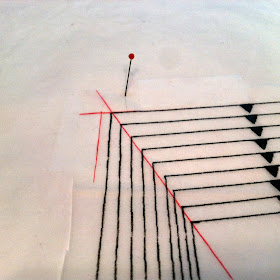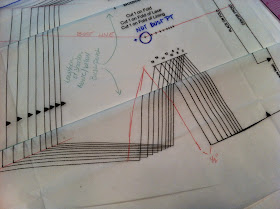Hi Everyone, this tutorial has long been requested and is LONG overdue. I thank you for your patience! Resizing a pattern from the size you have to the size you want isn't really as scary as it looks. Whether larger or smaller, the concept is the same, but to keep this manageable, I'm going to do this in two parts. My example this time will show you how to enlarge the size, and with part two, I will show you how to shrink it down.
Make your pattern smaller than the size you have with this tutorial Part II:
http://sewchicpatterns.blogspot.com/2015/05/pattern-resizing-part-2-larger-to.html
We will be using the Beatrice Pattern, #LN1310 to guide us through this instruction:
Buy your pattern here: http://www.sewchicpatterns.com/beatrice.html
To follow along with this tutorial you will need
- Your chosen pattern.
- Any pattern paper of your choice.
- A long see-thru ruler with a grid
- A curved ruler is nice, but optional
- Your personal measurements
1. Measure and Math
Have your measurements handy, grab the chart above, and let's do some math.I'm using some measurements from an imaginary person that wants to make up one of my patterns, but the chart range doesn't quite reach far enough. Put your measurements in that first column, and the chart measurements in the second column. Subtract one from the other, and put that number in the third column. This is the overall increase, but we need to disperse this measurement evenly on all 4 sides, (a front, a back, a right and a left side), so divide that overall number by 4 and put that in the last column. This is how much we will add to the side seam front and back.
You may ask- what if my pattern is a princess seam and there are 6 ways to disperse that measurement? The answer is yes, you can, and in some cases, should divide it by as many vertical seams as your pattern has, but this number may not be divided 6 ways equally. Plan it out so that the princess line will land just to the outside of the bust point, and put the rest at the side seam.
2. Tape paper to the pattern
For this example, I'm going to use the Beatrice pattern, #LN1313. Cut out the pattern pieces that you will need for your project. Because we are going to grow our pattern, tape some kind of pattern paper to the edges.3. Draw an extension line
Use a ruler to draw a grading point through the corner points of every edge. I'm going to call this an extension line. Notice that the regular changes in size not only include more width, but also include more height to make the change proportionate. You may or may not want to add more height to your pattern, but using this method, it's certainly an option.4. Start at the side seam
First we will concern ourselves with the width changes. Using my imaginary friends measurements, I need to add a total of 3" to the bust, and divided by 4, the change will be 3/4" from the size 18. At the waist, I need to add 1/2". Using a ruler, I've made a mark along the extension line.5. Work your way around the pattern
Working my way around the pattern piece, trace off the armscye, or armhole. You can also free-hand the armhole shape, but tracing is convenient.6. Option 1: Leave the shoulder height as is
According to my persons measurements, I don't need to "grow" the pattern and add more height, but I am going to add more width across the chest. Before you decide to do the same, take an arm measurement at the bicep and decide if you can stay with the size 18 sleeve as I will be doing, or if you will need to enlarge the sleeve proportionally as well. Will you need more room in the armhole for comfort? If so, then you should extend the shoulder height in sequence with the rest. We must shorten the pattern to match our body length later anyway, so adding height here is not going to cause you more work in the end. In this photo, I have squared off the pattern at the shoulder, and am not adding height as the grade would normally require.7. Matching my armscye corner to the corner of my shoulder, I can pivot the paper in or out just a little to match up with my side seam and add a tiny bit more, or less, fabric to the width across the chest. It does not match up perfectly, but is very close.
7a. Option 2: Add height at the shoulder
If you are extending the shoulder height by 1/4"- this is what your pattern should look like. I've added an extension line at the notch to make sure that matches up with the previous grade.
7b. Match the armhole tracing to the upper corner as mentioned before, with the notch also following in line with the others. The armhole will extend at the underarm to match the new size you will make for the sleeve. Measuring this addition reveals just about 3/8" will be added to each side of your sleeve. You will also need to raise the cap 1/4" to match the bodice.
7c. Extending the shoulder means extending the neckline too. Use the graded points to raise and redraw the front neckline.
8. Lengthen or Shorten
Now we need to think about shortening this bodice to match our figure. There are two places to shorten: above and below the bust point. This pattern has a little symbol above the cut out dart. The is NOT a bust point. It's the end point of your dart. However, the bust point isn't far from there- and the bigger a dart is, the nearer to the bust point your dart should end. I drew an arbitrary double line above and below the bust point because I figure our friend should be wearing a good quality bra that will keep those girls up high. Measuring from the waist, vertically up to the bust point you can determine if and how much should shorten below and anything left over should be shortened from above. We need to shorten 1" total, so I'm taking 3/4" from below and 1/4" from above. If you have added height to the pattern at the shoulder, don't forget to factor that into your back waist measurement. Fold one line up to match the other, and tape it to secure.9. Move the Dart
Do you need to move the dart? Measure yourself from bust point to point. Divide that measurement in half. Measure from the waist up to your bust point. Measuring the pattern over and down to the waist, find your bust point. Transfer that information to the pattern and mark your bust point. Use a ruler to draw a new line the corrected distance from the dart marked on the pattern. This is a cut line, not a sewing line.10. True (straighten) the side seams from end point to point
The dashed line outside the dart represents the sewing line. The newer pattern release has notches along this cut out dart, which this one does not have. True your side seams, mark the waist line and this front pattern is ready to go.11. Complete other pattern peices
Continue on with the other pattern pieces, moving the darts and adding to the side seams consistently as before until all pattern changes have been made, including facings. Keep a notebook or use a diagram to help you keep track, but always walk your pattern to be sure you haven't forgotten anything. Make a check mark on each seam that has been walked to partner so you don't have to worry. Checking this now will save your time, money and hassle down the road. If your chosen pattern has more pieces to it, such as the Tia dress, remember that the concept is the exactly the same. Make your marks at the side seam to personalize, and resize the pattern using the same grading lines, tapering as was done on the sizes before. Keep measurement changes the same throughout so that all the pieces will sew correctly to each other, walk your seams and that's all you need to resize your pattern from what you have to what you need! Stay tuned for part two where I show you how to reduce the size of a pattern.
Have a great sewing day!
~ Laura
















Great thinking! Might I suggest tracing the pattern first, and then altering from that? Yes, it takes longer, transfering all those marks, but if you mess up, you can go back and try again. Yes, this is the voice of Bitter Experience speaking....
ReplyDeleteGood suggestion! We do need all previous sizes to create our new pattern size, and since we aren't deleting anything we had before, I would suggest tracing off the new size for use and testing after it's complete. The first pattern change with all sizes becomes your master and you can come back to it to see exactly what you did. In case you need to make corrections or notes, it will be easy to start up where you last left off.
DeleteSo I'm trying to do this, but I the corners of all the sizes don't match up in order to draw a straight extension line... Should I just draw the line from smallest size to largest size?
ReplyDeleteIn point 6 you mention adjusting bicep size, but I can't find any information about bicep sizing in your patterns to use as a starting point.
ReplyDelete